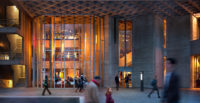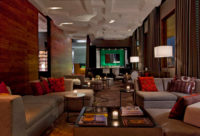Liverpool, United Kingdom
Liverpool’s new Everyman Theatre, which just won this year’s Stirling Prize for the top building in the UK, shows Haworth Tompkins Architects doing what it does best. The London-based firm excels at theater renovations in which the distinction between new and old becomes happily blurred rather than sharply defined. But with the Everyman, the architects applied their approach to an entirely new building, managing to make a modern theater feel long established.
The Everyman was updated in the mid-1970s, but by the early 21st century, the facilities were inadequate (especially deficient in backstage areas) and structurally dubious. In 2007, Haworth Tompkins won a competition to rebuild it from scratch. The brief from the client, artistic director Gemma Bodinetz, was consciously paradoxical: she wanted a total transformation of what the theater could do, but she also wanted her loyal patrons to feel that they recognized the place.
The theater acquired two adjoining sites, and from the exterior, you feel as if somehow the old theater has just been expanded into the new 50,500-square-foot, concrete-and-steel building. Even the former 1970s sign displaying its name in lowercase red letters appears to be present and intact, though neon has been replaced with LEDs and it is much larger, subtly tweaked by artist and typographer Jake Tillson. Above that is the key facade move, in which each of the 105 cast-aluminium sun-shading shutters on this west-facing building is adorned with a water-jet-cut image of a person. These are the everyfolk of Liverpool, the result of drop-in photo sessions open to the public, from which a selection of images was made. Each shutter is manually operable from inside, which randomizes the appearance of the facade according to weather and pattern of use. Above the shutters, a row of brick cylinders rises above the roof like a ship’s smokestacks. Stack-effect chimneys for the auditorium’s natural ventilation system, which promises to keep the space comfortable for most of the year, they helped the project achieve a BREEAM Excellent rating.
Inside, the public spaces felt used, familiar, even before they opened. On the street side is the main lobby and café, which open up via a double-height entrance space to a large upstairs bar on one side and a writers’ studio on the other. The pale, board-marked concrete of the structural beams and columns has an industrial quality—and it contains a high proportion of cement-replacing slag, which helps the building’s sustainability credentials. In the center of the plan, a steel frame allows for the large span required by the 400-seat theater and fly tower above it. The thrust stage juts into two horseshoe-shaped levels of seating.
The firm’s most dramatic act of resurrection involved salvaging 177-year-old bricks, 25,000 of them, from original chapel walls and reusing them in plain sight. They are especially effective where they form the back wall of the auditorium—again, you could easily think you were in a converted building, not a new one. “There was a strong public attachment to the Everyman as a carrier of cultural memory, and a consequent urge to maintain some physical manifestation of the old theater,” says Tompkins. “Our task was to find the right opportunity to achieve this without resorting to sentimentality.” The dull gold fabric used in the auditorium seats also recalls the color of the seating in the previous theater.
Balancing the auditorium, on the opposite side of the plan, is a full-size rehearsal stage on the ground floor and a reception area above—all vast improvements on the previous facility’s cramped quarters. At one point, more land became available, and the theater could have grown still bigger. Tompkins persuaded his client to keep things compact. As it was, he set back a portion of the main frontage lest the facade appear disproportionately long.
This, then, is a relatively small theater with a high profile —all the more so now that it has won the UK’s top architecture prize, against stiff competition. The Stirling citation summed it up well, calling the Everyman “groundbreaking as a truly public building” and “an extraordinary contribution to both theater and the city.”
People
Owner:
Architect:
Personnel in architect's firm who should receive special credit:
Interior designer:
Engineer(s):
Consultant(s):
Other:
General contractor:
Photographer(s):
H'l'ne Binet
CAD system, project management, or other software used:
Other Information if required Size: 50,500 square feet Construction cost: $21 million Completion date: December 2013 |
Products
Structural system
Manufacturer of any structural components unique to this project:
Exterior cladding
Other cladding unique to this project:
Roofing
Windows
Glazing
Doors
Sliding doors:
Special doors:
Hardware
Closers:
Pulls:
Other special hardware:
Interior finishes
Suspension grid:
Cabinetwork and custom woodwork:
Paneling:
Floor and wall tile:
Timber flooring:
Special interior finishes unique to this project:
Furnishings
Chairs:
Tables:
Lighting
Downlights:
Dimming System or other lighting controls:
Conveyance
Add any additional building components or special equipment that made a significant contribution to this project: |













Post a comment to this article
Report Abusive Comment